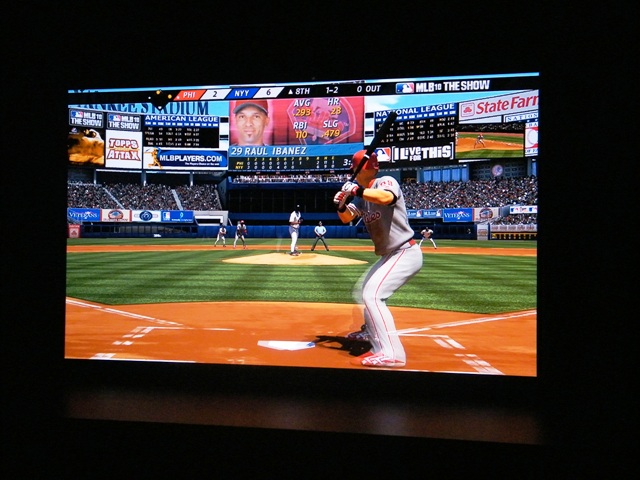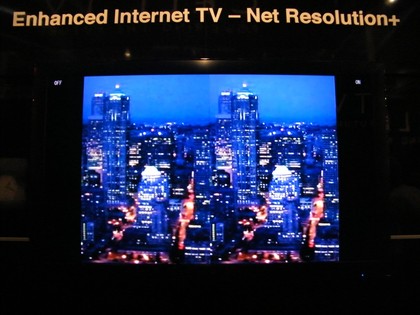The technology to expect in your next TV

Everybody is talking about 3D TV.
This year's CES was buzzing about it. Samsung, Panasonic, Sony, Toshiba and LG all showed off 3D-capable HDTVs, some with 2D-to-3D video conversion technology that claims to add depth to existing content on the fly.
More recently, Sky made broadcast history by showing Arsenal vs Manchester United in 3D. Later this year, Blu-ray 3D will bring high definition 3D movies into your living room. A 3D revolution looks inevitable, albeit slow to unfold.
Of course, 3D is also a convenient way for manufacturers to sell more HDTVs. Plummeting telly prices continue to benefit consumers – you can pick up a 5-star rated Samsung LE32B550 for less than £400.
But cheap HDTVs have also dented the profits of the big hardware manufacturers. It's why they'll be trying to convince you that your current HDTV is already out of date. Yes, it might have optimised gaming modes, DLNA connectivity, LED backlighting and internet widgets. But we bet your HDTV doesn't have...
Organic Light Emitting Diodes (OLED)
OLED is viewed as the natural successor to LCD. It boasts superior brightness and colour reproduction because the organic material used to construct an OLED panel emits its own light when charged, so there's no need for a separate backlight.
Sign up for breaking news, reviews, opinion, top tech deals, and more.
LED or otherwise. OLED and AMOLED displays are already being used on portable devices, including the Zune HD and Google Nexus One. They're also expected to make the transition to laptops – Dell recently teased an OLED-equipped Studio XPS.
Building OLED HDTVs is proving a bigger challenge. The problem is that OLED displays remain expensive to manufacture, especially in large sizes.
Not enough factories are geared up to produce them, so working TV prototypes are few and far between. But there have been some promising developments. Both Sony and Samsung showed off 3D-capable OLED concepts off at CES 2010.

Mitsubishi has recently unveiled a massive 149-inch prototype OLED display (consisting of several 10 x 10 cm panels) that will be appearing at the Integrated Systems Europe (ISE) show in February.
While the TV industry distracts itself with 3D, OLED and 3D OLED displays are undoubtedly the future of TV displays. But we might have to wait until the end of 2011, early 2012 before they become commercially available beyond the 11- and 15-inch novelty panels currently available.
Quad pixels
Manufacturers are always trying to improve the quality of their displays, whether it's through favouring PDP over LCD, boosting the refresh rate or adopting LED backlighting.
Sharp has taken a different tack. Its proprietary 'four primary colour' technology adds an extra yellow pixel to the existing Red, Green and Blue setup in a typical LCD.
Sharp's future Aquos models will feature this new RGBY technology to extend the gamut of viewable colours to more than a trillion. According to Sharp, this quad pixel approach will enable its LE920, LE810 and LE810 models to reproduce colours that have been "difficult to portray using conventional LCD displays, such as the golden yellow colour of brass instruments."
Multi-core processing power
The new Toshiba ZX900 Series Cell TV could be the shape of TVs to come. Featuring a version of the same Cell chip that powers the PlayStation 3, the ZX900 boasts eight co-processing cores running at 3.2GHz.
It has, says Toshiba, 143 times the multimedia prowess of its current MetaBrain TVs and is capable of upscaling HD content to Ultra HD and converting 2D video into 3D video in real-time.

The Cell chip can also juggle multiple video streams. The Japanese version of the Cell TV will incorporate 14 TV tuners – 11 digital terrestrial tuners, 2 digital satellite tuners and 1 analogue terrestrial tuner. According to Toshiba, it will be capable of recording eight programmes in parallel or displaying them simultaneously in split-screen.
- 1
- 2
Current page: OLED screens and multi-core processors
Next Page Lenticular lenses, Ultra HD, return of portable